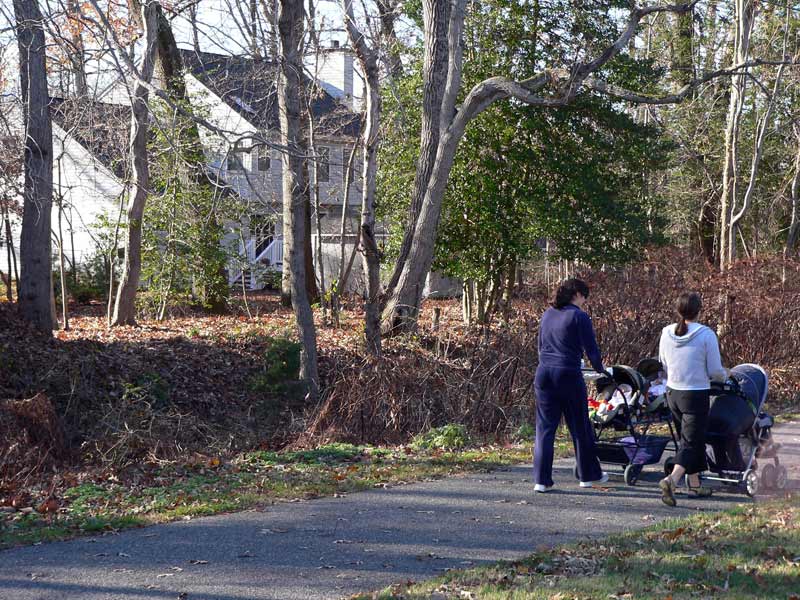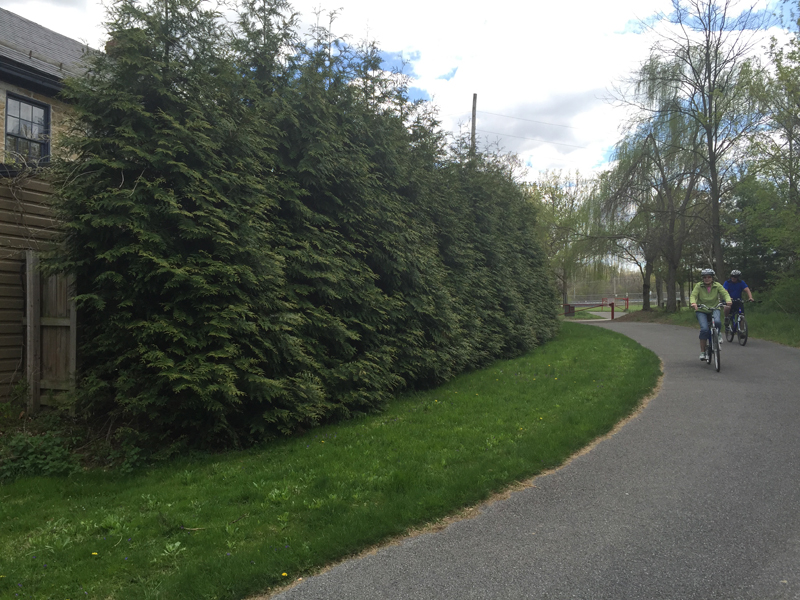By Meg Muckenhoupt
Community paths allow more people to travel without using cars—and a lot of people want to do just that. It is estimated that more than 2 million people walk, run, and bike the Minuteman Bikeway in Cambridge, Arlington, Lexington, and Bedford each year. Understandably, neighbors living in homes abutting new paths are often concerned about the effects of having so many visitors passing by their yards. Different communities have varying approaches to living with bike trails.

Single-family homes along the Baltimore-Annapolis rail trail./ Stuart Macdonald /National Trails Training Partnership
Today, 22 years after the Minuteman Bikeway officially opened, about a quarter of properties abutting the Bikeway in Arlington have no barrier between the bikeway and abutting buildings at all. Roughly 30% of single-family homes did not have any fence or screening. (See “Many Bikeway Abutters Forgo Trail Barriers,” Belmont Citizens Forum Newsletter, November/December 2013.) For buildings which did have barriers, the material of choice was chain link fencing (46% of buildings), followed by wood fencing (23%). Only two percent of bike path neighbors chose to erect a stone wall.
According to trail planners at the National Trails Training Partnership and the Rails to Trails Conservancy, many community path neighbors choose to have no fencing at all. “The York County [PA] Rail Trail Authority gave three adjacent property owners $1,500 to build whatever type of fence they wanted. None of them built any fence at all,” wrote Carl Knoch, Manager of Trail Development, Rails-to-Trails Conservancy.
Sometimes, abutters decide they want less fencing. In 2001, the residents of Avon, CT, asked the town to remove two miles of chain-link fencing that the town had erected along a new community path at the residents’ request. The residents asked the town to replace the fence with split-rail fencing to make the path more accessible. In the end, the town agreed that new sections of path would have split-rail fencing, but declined to remove the existing fencing.
Beverly Woods, a Bruce Freeman Rail Trail advocate, wrote in 2003, “I recently received a phone call from an abutter in the Heart’s Pond neighborhood who has been a vocal opponent for years. His children have now reached the age where they have learned to ride bicycles. He spent this past summer taking them to various bike paths around the state and now thinks they are wonderful facilities. He can’t wait for construction of the Bruce Freeman to start and would like the fence he requested eliminated from the plan.”
Trees as Fence

Arborvitae vegetation screen along bike path, Heritage Rail Trail County park in York County, PA. / Carl Knoch
Abutters sometimes erect fences on their property to block access from a path to their property. Very few homeowners build soundproof fencing along community paths; compared to the noises from a train or a busy road, the sounds issuing from community paths are quiet.
Instead, the path abutters who do build fences want to block the view of their yards. In some cases, homeowners combine fences with trees or shrubs. Evergreens provide the best year-round screening. The National Arbor Day Society recommends American arborvitae (Thuja occidentalis), a giant green cone of a tree which can grow up to 30’ tall, and spread up to 12’.
However, a monotonous green wall can be unattractive, or just plain dull. Penn State University’s Extension recommends layered screening, placing smaller trees and bushes in front of the giants to provide variety and seasonal color. Smaller, fast-growing trees can also provide good screening while the big trees are just starting to gain height. Arborvitae is native to eastern Canada, but several Massachusetts native plants can also provide good screening and are recommended by the Penn State and Virginia Tech extensions. They include American holly (Ilex opaca), white pine (Pinus strobus), and great laurel (Rhododendron Maximum).
Meg Muckenhoupt is editor of the Belmont Citizens Forum Newsletter


Sorry, the comment form is closed at this time.